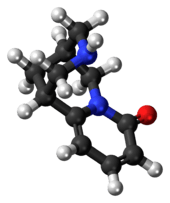Cytisine
-Cytisine.svg.png) | |
 | |
| Names | |
|---|---|
| IUPAC name
(1R,5S)-1,2,3,4,5,6-Hexahydro-1,5-methano-8H-pyrido[1,2a][1,5]diazocin-8-one | |
| Other names
Cytisine Baptitoxine Sophorine | |
| Identifiers | |
| 485-35-8 | |
| 3D model (Jmol) | Interactive image |
| ChEBI | CHEBI:4055 |
| ChEMBL | ChEMBL497939 |
| ChemSpider | 9818 |
| ECHA InfoCard | 100.006.924 |
| 5347 | |
| PubChem | 10235 |
| UNII | 53S5U404NU |
| |
| |
| Properties | |
| C11H14N2O | |
| Molar mass | 190.24 g/mol |
| Melting point | 152 to 153 °C (306 to 307 °F; 425 to 426 K) |
| Boiling point | 218 °C (424 °F; 491 K) at 2 mmHg |
| Except where otherwise noted, data are given for materials in their standard state (at 25 °C [77 °F], 100 kPa). | |
| | |
| Infobox references | |
Cytisine, also known as baptitoxine and sophorine, is an alkaloid that occurs naturally in several plant genera, such as Laburnum and Cytisus of the family Fabaceae. It has been used medically to help with smoking cessation.[1] Its molecular structure has some similarity to that of nicotine and it has similar pharmacological effects. Like varenicline, cytisine is a partial agonist of nicotinic acetylcholine receptors (nAChRs). Cytisine has a short half-life of 4.8 hours, and is rapidly eliminated from the body. The use of cytisine for smoking cessation remains relatively unknown outside Eastern Europe.
Sources
Plant species that contain cytisine are found in several genera of the Faboideae subfamily of the Fabaceae family, including Laburnum, Anagyris, Thermopsis, Cytisus, Genista, Retama and Sophora. Cytisine is also present in Gymnocladus of the Caesalpinioideae subfamily.
Uses
Smoking cessation
As a pharmaceutical preparation called Tabex or Desmoxan, cytisine has been used in Eastern Europe available for the treatment of tobacco smoking. Cytisine has some structural and pharmacological similarities to the smoking cessation drug varenicline.
Cytisine is an acetylcholine agonist, and has strong binding affinity for the nicotinic acetylcholine receptor. It is extracted from the seeds of Cytisus laborinum L. (Golden Rain acacia) and has been available in former socialist economy (FSE) countries for more than 40 years as an aid to smoking cessation under the brand name Tabex produced by the Bulgarian pharmaceutical company Sopharma AD. It was first marketed in Bulgaria in 1964 and then became widely available in FSE countries.
In 2011, a randomized controlled trial with 740 patients found cytisine improved 12-month abstinence from nicotine from 2.4% with placebo to 8.4% with cytisine.[2] A 2013 meta-analysis of eight studies demonstrated that cytisine has similar effectiveness to varenicline but with substantially lower side effects.[3] A 2014 systematic review and economic evaluation concluded that cytisine was more likely to be cost-effective for smoking cessation than varenicline.[4]
Recreational
Plants containing cytisine, including the scotch broom and mescalbean, have also been used recreationally. Positive effects are reported to include a nicotine-like intoxication.[5] However, this practice is not recommended, since negative side effects can include nausea, vomiting, convulsions, heart pain, headache and, in larger doses, even death via respiratory failure.
Reagent for organic chemistry
(-)-Cytisine extracted from Laburnum anagyroides seeds was used as a starting material for the preparation of "(+)-sparteine surrogate," for the preparation of enantiomerically enriched lithium anions of opposite stereochemistry to those anions obtained from sparteine.[6]
Toxicity
Cytisine can interfere with breathing and cause death; LD50 i.v., in mice is about 2 mg/kg.[7] Cytisine is also teratogenic.[8]
Māmane (Sophora chrysophylla) can contain amounts of cytisine that are lethal to most animals. The palila (Loxioides bailleui, a bird), Uresiphita polygonalis virescens and Cydia species (moths), and possibly sheep and goats are not affected by the toxin for various reasons, and use māmane, or parts thereof, as food. U. p. virescens caterpillars are possibly able to sequester the cytisine to give themselves protection from getting eaten; they have aposematic coloration which would warn off potential predators.[9]
References
- ↑ Walker N, Howe C, Glover M, McRobbie H, Barnes J, Nosa V, Parag V, Bassett B, Bullen C (2014). "Cytisine versus Nicotine for Smoking Cessation". New England Journal of Medicine. 371 (25): 2353–62. doi:10.1056/nejmoa1407764. PMID 25517706.
- ↑ West R, Zatonski W, Cedzynska M, Lewandowska D, Pazik J, Aveyard P, Stapleton J (2011). "Placebo-Controlled Trial of Cytisine for Smoking Cessation". New England Journal of Medicine. 365 (13): 1193–1200. doi:10.1056/NEJMoa1102035. PMID 21991893.
- ↑ Hajek, McRobbie and Myers (25 Feb 2013). "Efficacy of cytisine in helping smokers quit: systematic review and meta-analysis". Thorax. 68 (11): 1037–42. doi:10.1136/thoraxjnl-2012-203035. PMID 23404838.
- ↑ Leaviss, Joanna; Sullivan, William; Ren, Shijie; Everson-Hock, Emma; Stevenson, Matt; Stevens, John; Strong, Mark; Cantrell, Anna (2014). "What is the clinical effectiveness and cost-effectiveness of cytisine compared with varenicline for smoking cessation? A systematic review and economic evaluation". Health Technology Assessment. 18 (33). doi:10.3310/hta18330.
- ↑ See West cited above
- ↑ "Synthesis of (+)-(1R,@S,9S)-11-Methyl-7,11-Diazatricyclo[7.3.1.02.7]tridecane, a (+)sparteine surrogate". Organic Syntheses. 83: 141. 2006. doi:10.15227/orgsyn.083.0141.
- ↑ The Merck Index, 10th Ed. (1983) p.402, Rahway: Merck & Co.
- ↑ R. F. Keeler. Handbook of Natural Toxins: Toxicology of Plant and Fungal Compounds. CRC Press. p. 43.
- ↑ Banko, P. C.; Cipollini, M. L.; Breton, G. W.; Paulk, E.; Wink, M.; Izhaki, I. (2002). "Seed chemistry of Sophora chrysophylla (mamane) in relation to diet of specialist avian seed predator Loxioides bailleui (palila) in Hawaii" (PDF). Journal of Chemical Ecology. 28 (7): 1393–410. doi:10.1023/A:1016248502927. PMID 12199503.
External links
- Cytisine Is Cheap And Effective In Helping Smokers Quit Information on treatment of tobacco smoking
- Tabex official website
- Reinberg, Steven. "Cheap Natural Compound May Help Smokers Quit". U.S. News & World Report. Retrieved 18 December 2014.